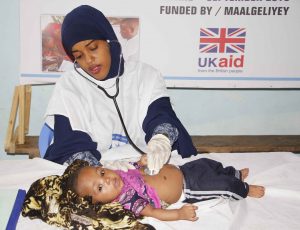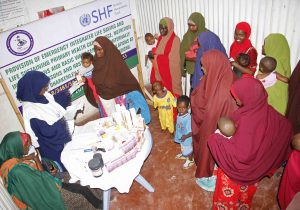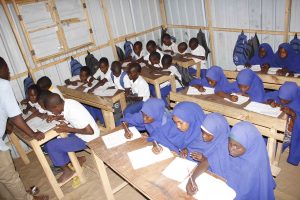1. Background and Humanitarian needs
The floods and storm have resulted in deaths and affected livelihoods, livestock, shelter and key infrastructure across the country. There is a high risk of the outbreak of water-born communicable diseases including malaria and AWD/cholera in several areas. An estimated 794,761 people have been affected by the flooding in southern and central states and more than 231,335 are temporarily displaced, according to the UNHCR-led Protection & Return Monitoring Network (PRMN). So far, 21 people are confirmed dead including nine in Hirshabelle State, four in Jubaland State and eight in Banadir region.
In Banadir region, flash flooding on 20 May, affected primary and secondary roads in Mogadishu – damaging many and rendering them temporarily impassable – and damaging settlements inhabited by IDPs, particularly on the outskirts of the city and along the Afgooye corridor. Eight deaths were confirmed with seven of them being children. Authorities and humanitarian partners are working to establish the full extent of the damage, though the office of the Mayor estimates damage to total $35 million. Thousands of people have been affected and businesses disrupted. The IDPs settlements have been particularly affected: in Kahda district, 60 latrines mostly for IDPs who were evicted on 29 and 30 December 2017, were damaged or destroyed along with shelters. Many IDPs are subsequently living in open fields. IDP settlements along Afgooye corridor are affected, including Harqabobe IDPs Center (700 households), Luuq Ganaane (85 households), and Tawakal (95 households). Shelter, WASH and non-food items (NFI) are the most urgent priorities for affected households.
However, SOYDA have been providing integrated package of nutrition, Food Security, Education, WASH, protection, and health intervention in both Mogadishu IDPs as well as the Afgooye corridor district.
SOYDA shall however, continue its program implementation to enable reduce the vulnerability as well as provide improved lifesaving Health, Nutrition, WASH, Food Security, Protection and Education services.
i. Program effectiveness.
The overall program management was assured by strong capacities in planning, implementation and monitoring through a very qualified and well-organized team and leaderships in Lower Shabelle and Banadir region. It worked through integration of health programs in which SOYDA was also in partnership with SHF, DFID and UNICEF Somalia.
The program adopted an effective participatory approach for assessing community needs and designing the interventions. The technical designs and choice of interventions considered the needs of the beneficiaries and technical viability of the structures in the different geographical locations. Supplement distribution (RUTF) involved the beneficiaries directly by engaging them through mobile and static nutrition interventions as well as mobile clinic, an excellent approach that provided immediate lifesaving and life sustaining health and nutrition intervention in the target locations.
The program produced important immediate results that show high prospects for larger impacts. Within its limited scope, the program reached vulnerable households as well as enabling equitable access to essential health and nutrition services. During the program implementation, the community members expressed their satisfaction, and it was clear their relationship was very good. The community nutrition education improved health and nutrition seeking behaviour of the communities, through the effective community health workers engagement on daily screening and referral as well as the traditional birth attendance who have visited the homes time to time in order to ensure the pregnant mothers deliver safely at SOYDA facilities. SOYDA enrolled 200 IDP children and provided teaching/learning materials and emergency teaching incentives. To increase school-aged children to go to school, SOYDA routines provides school feeding to 500 children (200 new children and 300 children at the school) shared equally boys and girls to attract parents to allow their children to schools, avoid malnutrition among the children and prevent excess dropouts.
Through the community health workers the project was able to reach the community members and provided the services to their doorstep, this has led to decreased in AWD/cholera related disease reported high before the initiation of the project.
i. Program activity achievement.
The following were some of achievement recorded in this quarter April-June 2018, they includes:
• A total of 42,883 number of crisis affected women, children and Men in emergency was reached with improved life-saving primary health care services, However, integration of nutrition, WASH, protection and health have helped the community members have better lifesaving nutrition and health services with easy access to the facilities and mobile sites.
• Through the facility and outreach program sites SOYDA was able to reach a total of 9,875 children under five boys and girls for vitamin A supplementation to enable enhance the vulnerable children nutrition status. This has since be able the program to reach more than 79% of the quarterly coverage under five children thus indicating greater progress to the set indicators within the program.
• SOYDA continuously conducting routing immunization in all the project target sites for health and nutrition however, in this reporting quarter, it was able to reach Routine measles immunization in both the facility base as well as outreach mobile services hence the program have been able to reach a total of 5289 children. This has since improved the quality of the target beneficiaries in all the program areas.
• Skilled delivery is the core of primary health care services thus the project was able to record success in both facilities and at home visit for the traditional birth attendance hence encourage facility delivery and passed knowledge and information to the mothers in the target areas for safe motherhoods hence this reporting quarter a total 878 safe delivery were conducted in SOYDA health and Nutrition facilities. This improvement was also attributed closer coordination between the program outreach team as well as community traditional birth attendants in the project areas.
• The project was able to attend to a total of 6,167 pregnant and lactating mother’s antenatal care (ANC 1st visit) in this reporting period and has since completed all the 4 comprehensive ANC visit. The program has recorded success in all reaching the vulnerable mothers with improved maternal health care services in both facilities and outreach sites program.
• On the same reporting period a total of 665 women of reproductive age have received T1-T5. The community health workers are continuously conducting community sensitization and education in the project areas.
• Through this reporting quarter a total of 3891 <5 children received penta 1-3 in both the mobile outreach project sites as well as the facility base program sites, this has since provided the target beneficiaries enhance access to feasible emergency integrated nutrition and primary health care services.
• 1766 Children and PLW were provided acute malnutrition treatment and also provided IYCF and NHHP counseling during this reporting period.
• 679 Hygiene kit distributions were done to the discharged CTC patients.
• On GBV responses, 348 cases were provided STI treatment, basic emotional support and psychosocial support.
• 10th -14th May 2018, Conducted 5 days Integrated Management of Childhood-Illness for SOYDA 39 Health and Nutrition project staff in order to improve their capacity on prevention, diagnosis and treatment on communicable diseases
• 19th -23th April 2018, Conducted WASH Committee training on better water resource management, well chlorination, bucket disinfection, HHWT use, and maintenance of water facilities.
• 08nd -12th April 2018, Conducted 5 days training on IYCF training for SOYDA project staffs
• SOYDA launched the commemoration of world Health Day Celebration on 7th April 2018, through provision outreach medical campaigns in Mogadishu and Afgooye corridor IDPs in Our Project Areas as part of scaling up and reaching more IDPs.. The World Health Day is a global health awareness day celebrated every year on 7 April, and theme is health for all, Health is a human right. It’s time for Universal Health Coverage for everyone, everywhere. We provided 167 (69 Children and 98 Adults) patients for medical checks, consultation, immunization, treatments and referral of the severe cases through the campaign that marked World Health Day commemoration. The key message is Universal health coverage which is about ensuring all people can get quality health services, where and when they need them
• Provided support school feeding programmes to 500 pupils (200 new children and 300 children already enrolled in the school) to attract parents to allow their children to schools, avoid malnutrition to the pupil and prevent excess dropouts.
• Distributed basic learning and teaching materials for the students and the schools to help them continue their education. The items distributed include exercise books, pen, pencil, sharpeners, erasers, mathematic sets for both teachers and students and mixed color dustless chalk. These materials are intended to contribute to the retention of the children and improved quality of teaching and learning system in the target schools.
• Constructed 5 water kiosks and extended pipelines in Afgooye corridor IDPs and school children site.
• Constructed hybrid solar powered system, in order to reduce the running cost of the borehole and receive the IDPs and host community with reasonable and affordable price for the continuation of the sustainability of the water source.
ii. Challenges/Constrains.
Some of the bottlenecks experience during this reporting period is as follows:
• High number of displaced person from flood affected areas in lower Shabelle region.
iii. Lesson learnt.
The following were some of the lesson learns during this quarterly reporting period.
• Strengthen and improve nutrition communication and advocacy through National and sub national cluster.













